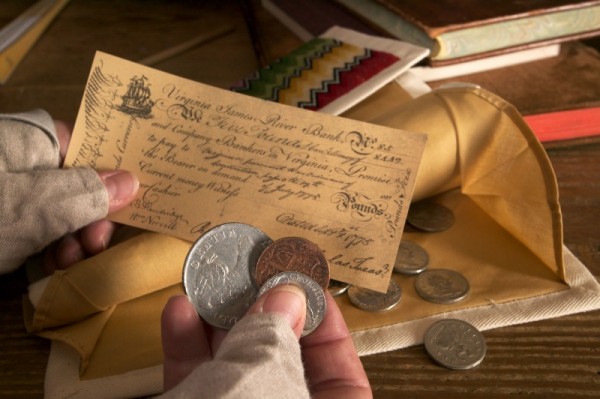 If you visited Williamsburg’s Market House in the late eighteenth century, you would see customers making their purchases in a variety of ways. In some instances, customers might barter goods or services for their purchases. Merchants could offer credit at their stores, and those short of cash could turn to “country pay,” using foodstuffs and tobacco as currency, the latter at a rate set by the legislature. Sellers and buyers would periodically review and settle their accounts.
If you visited Williamsburg’s Market House in the late eighteenth century, you would see customers making their purchases in a variety of ways. In some instances, customers might barter goods or services for their purchases. Merchants could offer credit at their stores, and those short of cash could turn to “country pay,” using foodstuffs and tobacco as currency, the latter at a rate set by the legislature. Sellers and buyers would periodically review and settle their accounts.
Very often, coinage or paper money changed hands. British coins were minted in a number of denominations, from fractions of a penny to more than a pound. Before the 1770s, relatively little British coinage circulated in Virginia, so residents were comfortable using a range of coins from other empires, particularly Spain. According to Colonial Williamsburg’s curator of Mechanical Arts and Numismatics (historical currency specialist) Erik Goldstein, a Spanish silver coin called a pistareen, worth two reales, was the most common silver coin circulating in mid-eighteenth century Virginia. Spanish colonial reales, then valued at about ten pence, have also been unearthed at many sites in Williamsburg. After the British government minted and shipped 1773-dated Virginia copper halfpence the following year, they became very common. And in 1775, Virginia’s paper money began to be issued in large quantities. The smallest denomination, however, was one pistareen, which had a value of one shilling and three pence –showing that Virginians were so accustomed to this denomination that it warranted a paper equivalent.
Approximately one third of a silver sixpence of Elizabeth I, dated 1582, found during excavation at the Kendall-Gardner site in Williamsburg. The thin coin is heavily worn and most likely was clipped.
Because so many different coins were in circulation, they were often weighed to determine their value based on their metal content, rather than taken at face value and converted into pounds, shillings, and pence. All silver and gold coinage might be “clipped” – trimmed of small amounts of metal which made the coins worth less than their face value, and allowing the clipper to profit illegally. To make change for a customer using coins, the seller could cut a coin into halves, quarters, or even eighths and return the appropriate amount to the buyer. These “bits” would be useful for making other small purchases. Many of the coins excavated in the Historic area were halved or quartered, some of which were probably dropped by customers as they went about their daily lives.
Contributed by Lindsay Keiter, Associate Historian, Digital History Center.

Leave a Reply